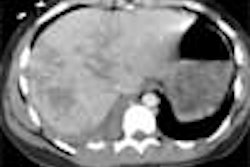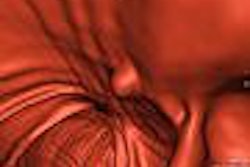CHICAGO - Researchers in Germany have found that aortic valve calcification -- rarely measured on its own -- is closely correlated to the degree of aortic stenosis. As a result, the investigators are recommending the routine calculation of such annular calcifications in patients undergoing coronary CT calcium assessment.
That calcium in the aorta should indicate aortic stenosis is intuitive, of course, but the researchers' ability to demonstrate the phenomenon clinically is also a tribute to the evolution of multidetector-row CT, which can deftly visualize the aortic valve throughout the cardiac cycle.
The researchers, from the University of Aachen in Germany, measured the calcium on a 16-row scanner (Sensation 16, Siemens Medical Solutions, Forchheim, Germany). They assessed the degree of aortic stenosis with cardiac catheterization, performing biplane ventriculography and assessing cardiac output according to AJACC guidelines. Then they correlated the aortic valve area with the degree of calcification seen on MDCT, calculating aortic valve calcification using the Agatston score, calcium mass, and calcium volume. The software summed up the coronary calcium score plus the aortic valve score.
"It's very important to remove all parts of the aortic ring to include just the leaflet (calcifications) in the study," said lead investigator Dr. Andreas Mahnken, who presented the results on Monday at the RSNA meeting. "We know from other studies that calcifications of the aortic ring are not correlated to the severity of aortic valve stenosis. That's one of the key issues in postprocessing."
Between October 2003 and April 2004, the researchers prospectively examined 75 patients on MDCT using 12 x 0.75-mm collimation, rotation time 420 msec, 133 mAs effective tube current, and 120 kVp. The images were reconstructed at 60% of the RR interval using 3-mm slice thickness and 2-mm reconstruction intervals. The results were compelling.
"In mild stenosis there was a lower calcium mass than in moderate or severe stenosis; the same was true in Agatston score and volume score," Mahnken said. The aortic valve calcium scores showed a significant inverse correlation with aortic valve area (p < 0.001 for all scores). Moreover, the aortic valve calcium scores were significantly higher in the 48 patients with severe aortic stenosis (calcium mass 1,016 ± 566 mg) compared to the 16 patients with moderate (calcium mass 445 ± 141 mg), or the 11 patients with mild aortic stenosis (calcium mass 217 ± 178 mg).
"We found an Agatston score of roughly 3,400 to have a specificity of 100% for severe aortic valve stenosis, and of course you can calculate the same values for calcium mass as well as calcium volume," Mahnken said. "So let me conclude that the severity of aortic valve stenosis is inversely correlated to the (aortic valve calcium) score, and that a high aortic valve calcium score, above roughly 3,400, indicates severe aortic stenosis. We need to calculate the (aortic valve calcium) data of patients who undergo cardiac CT for coronary calcium scoring, in case calcifications of the aortic valve are present."
Session moderator Dr. Lawrence Boxt, a professor of clinical radiology at Beth Israel Deaconess Medical Center in New York City, asked Mahnken if the group found any correlation between the amount of annular calcification and leaflet calcification, as Boxt and colleagues have seen in their own limited experience.
"We didn't perform a correlation but just from the visual impression (our experience) is the same," Mahnken said. "What we also saw was in patients with kidney problems as well as diabetes, the relation between aortic valve calcification and aortic ring calcification seems to be even more present than in patients without any other known disease."
By Eric Barnes
AuntMinnie.com staff writer
December 1, 2004
Related Reading
Scan centers take heart in 'Clinton syndrome', September 16, 2004
Most MDCT scanners fall short in cardiac imaging, September 3, 2004
Study validates cheap and easy method for atherosclerosis screening, July 30, 2004
Coronary calcium score is an effective prognostic tool for patients with diabetes, May 24, 2004
Radiologists correlate coronary calcium with other CVD markers, April 6, 2004
Copyright © 2004 AuntMinnie.com



















